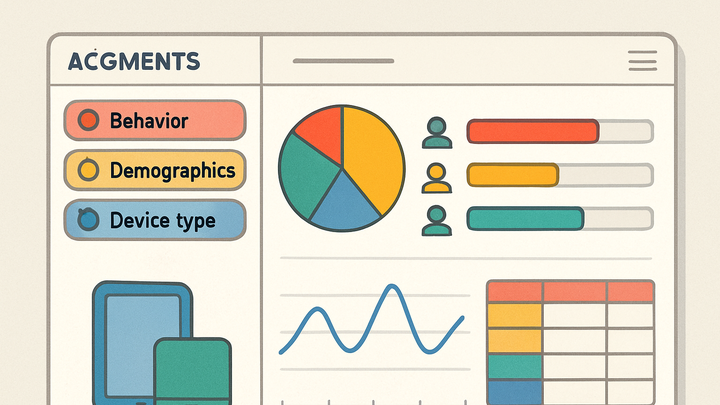Published on 2025-06-22T05:37:10Z
What is a Segment? Examples in GA4 and PlainSignal
In web analytics, a segment refers to a subset of your overall data that matches one or more specified criteria. By isolating this group of users or sessions, you can perform focused analysis on behaviors, demographics, or technical attributes without the noise of unrelated data. Segmentation helps uncover trends, compare performance across different audiences, and test hypotheses more effectively. Analytics platforms like Google Analytics 4 offer advanced segment creation tools, while privacy-focused solutions like PlainSignal provide simple filtering options to achieve similar results. For example, you might create a segment for users who visited the pricing page multiple times or those coming from a specific marketing campaign. Leveraging segments leads to deeper insights, improved personalization, and smarter decision-making.
Segment
A segment is a filtered subset of analytics data, allowing focused analysis of specific user groups and behaviors in tools like GA4 and PlainSignal.
Understanding Segments in Analytics
A segment in analytics is a subset of your overall data that shares defined attributes or behaviors. It allows you to isolate and analyze specific visitor groups based on criteria like demographics, behavior, or device. Segments filter your metrics and dimensions to show only relevant data, making analysis more focused.
-
What is a segment?
A segment is a defined subset of users or sessions selected based on one or more conditions. For example, users from a specific country or sessions with a certain event count.
-
Common segment types
Segments often fall into categories based on the attributes used to define them:
-
Demographic
Groups based on user attributes like location, language, or age.
-
Behavioral
Groups defined by actions such as page views, event completions, or session duration.
-
Technical
Groups filtered by device type, browser, or operating system.
-
Why Segments Matter
Using segments helps uncover insights hidden in aggregate data by focusing on specific slices of traffic. They support targeted marketing, personalized content, and performance optimization.
-
Enhanced insights
Isolating a segment reveals unique behaviors and trends that may be masked in overall reports.
-
Personalization and targeting
Segments enable you to tailor experiences and campaigns to specific user groups.
-
Performance monitoring
Track how different segments respond to changes in content, design, or marketing efforts.
Creating Segments in Google Analytics 4
GA4 offers a robust segment builder in both standard reports and the Explore section. You can define segments using dimensions and metrics, then apply them to filter your data across reports.
-
Accessing the segment builder
In GA4, navigate to Explore and click Segments to open the segment creation interface.
-
Defining conditions
Set conditions using dimensions (e.g.,
page_location contains /pricing) and metrics (e.g.,session_start > 1). -
Applying segments
Once saved, segments can be applied to your reports or exploration tabs to filter data in real time.
-
Example
Create a segment for users who visited the pricing page at least twice:
- Condition:
page_location contains /pricing - Metric:
event_count > 1
- Condition:
Filtering Data in PlainSignal
PlainSignal is a lightweight, cookie-free analytics solution that provides basic filtering features. You can apply filters to approximate segments by focusing on specific pages, referrers, or custom properties.
-
Installing PlainSignal
Embed the PlainSignal tracking script in your
<head>section:<link rel="preconnect" href="//eu.plainsignal.com/" crossorigin /> <script defer data-do="yourwebsitedomain.com" data-id="0GQV1xmtzQQ" data-api="//eu.plainsignal.com" src="//cdn.plainsignal.com/plainsignal-min.js"></script> -
Applying filters
Use the dashboard’s filter controls to narrow down data by page path, referrer, country, device, OS, or any custom event property.
-
Use cases
- Campaign Analysis: Filter by referrer to evaluate marketing channels.
- User Type: Segment logged-in vs anonymous users using custom properties.
- Device Breakdown: Analyze behavior on mobile vs desktop devices.
Best Practices for Segment Analysis
Implement segments thoughtfully to ensure accurate analysis and actionable insights. Follow these guidelines to get the most from your segments.
-
Keep criteria clear
Define segment conditions precisely to avoid ambiguity.
-
Use consistent naming
Adopt a naming convention that describes the key criteria and date (e.g.,
Mobile Users - July 2025). -
Validate segment quality
Compare segment results against raw data to ensure filters capture the intended audience.
-
Limit segment complexity
Avoid overly complex segments that are difficult to interpret and maintain.
